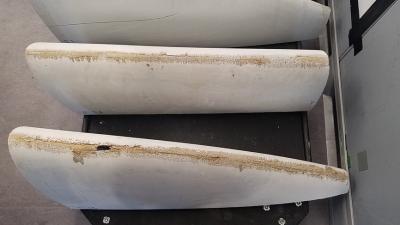Improved Estimates of Drivers of Wind Turbine Blade Leading Edge Erosion
Material loss from wind turbine blades is referred to as leading-edge erosion (LEE). It is associated with degradation of aerodynamic efficiency and thus loss of electrical power production. A major cause of LEE is materials stresses deriving from collisions between the rapidly rotating blades (tip speeds of 70-90 m/s) with falling precipitation (hydrometeors falling at up to 10 m/s). The closing velocity between rotating blades and falling hydrometeors and kinetic energy transferred to the blade are functions of the wind speed (which determines the blade rotation speed) and the hydroclimate. The more kinetic energy transferred to the blade, the higher the resulting materials stresses. Our project developed new methods to quantify the spatial variability in leading-edge erosion potential from atmospheric drivers using a kinetic energy-based approach and data from RADARs.
A robust and flexible framework has been developed and presented for generating an observationally constrained georeferenced assessment of precipitation-induced wind turbine blade leading edge erosion potential. The tool proposed here is based solely on publicly available data products from the National Weather Service dual-polarization RADAR and is used to provide a first assessment of the erosion climate across CONUS. It is an important first step towards enabling an assessment of the threat of excessive precipitation-induced LEE in a given deployment environment and the cost-effectiveness of options to reduce the likelihood of premature blade damage.
The imperative to transform the energy system is well documented and great strides have already been made to increase the penetration of low carbon sources into the global electricity supply. Wind energy has exhibited dramatic cost reductions and there are projections for continued reductions in the Levelized Cost of Energy from wind turbines. The tendency towards deployment of larger wind turbines with increased rotor tip speeds may be associated with increased risks of precipitation-induced damage to the wind turbine blade leading edge and the resulting degradation of electricity generation and increased repair costs. Thus, there is an urgent need to provide a priori estimates of leading-edge erosion across CONUS.
We have developed a novel approach to characterizing the erosion potential across the contiguous USA based solely on publicly available data products from the National Weather Service dual-polarization RADAR. Our approach is described in detail and illustrated using six locations distributed across parts of the USA that have substantial wind turbine deployments. Results from these locations demonstrate the high spatial variability in precipitation-induced erosion potential, illustrate the importance of low-probability high-impact events to cumulative annual total kinetic energy transfer, and emphasize the importance of hail as a damage vector. The importance of hail as a damage vector is to some degree unique to the USA and derives in part from the very high frequency of deep convection and hail in parts of the USA with high wind resources.

